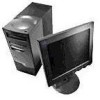IBM 6868 User Guide - Page 70
ACPI standby mode, Standby Mode S1, Setting power-management features
 |
UPC - 087944494911
View all IBM 6868 manuals
Add to My Manuals
Save this manual to your list of manuals |
Page 70 highlights
ACPI standby mode When you select the ACPI BIOS IRQ, you can also select which power level (S1 or S3) your system goes to when it enters standby mode. Standby Mode S1 When Your computer enters S1 Standby Mode, power is maintained to all devices but microprocessor activity is halted. Standby Mode S3 When the computer enters S3 mode, power is maintained only for main memory. Some computers do not support Standby Mode S3. If the Standby Mode setting in the Configuration/Setup utility program does not allow you to select S3, your computer only supports Standby Mode S1. If the Standby Mode setting in the Configuration/Setup utility program allows you to select S3, be sure to read the following important information. Important Some adapters might not wake up properly from standby mode S3. If your computer appears to have stopped and will not wake up from standby, press and hold the power switch for 5 seconds. Your computer will exit standby mode and turn off. Press the power switch to turn the computer back on. If you encounter a problem with Standby Mode S3, set this option to S1 and check to see if updated device drivers that support Standby Mode S3 are available for your adapters. Setting power-management features With power management, the computer and monitor (if the monitor supports DPMS) can be set to go into a reduced power state if they are inactive for a specified length of time. Time to Low Power: When you enable Automatic Hardware Power Management, you can use this option to specify the amount of time that the computer must be inactive before power-management features are activated. System Power: You can select ON if you want the computer to remain on or OFF if you want the computer to shut down. Display: You can use this option to select one of the following reduced-power states: 56 IntelliStation User Guide















